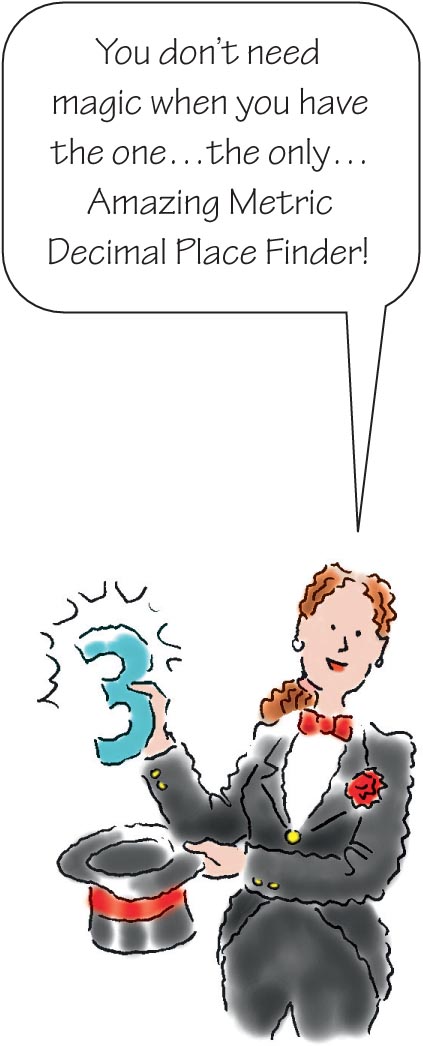Because the metric system is decimal based, converting from one metric unit to another is easy. To convert a smaller unit to a larger unit, move the decimal point to the left. To convert a larger unit to a smaller unit, move the decimal point to the right.

All metric units are multiples or subdivisions of the major units. So, you can convert a smaller unit to a larger unit by dividing by the appropriate multiple or multiplying by the appropriate subdivision. To convert a larger unit to a smaller unit, multiply by the appropriate multiple or divide by the appropriate subdivision.
Turning the tables on measurements 
Luckily, there are tables you can turn to for help in quickly converting measurements. (See Insta-metric conversion table, and Amazing metric decimal place finder.)
Converting meters to kilometers
Suppose you want to convert 15 meters (m) to kilometers (km). There are two ways to get this done.
Dancing decimal
Using the Amazing metric decimal place finder, you can follow these steps:
Count the number of places to the right or left of meters it takes to reach kilo. You'll see that kilo is three places to the left, indicating that a kilometer is 1,000 times larger than a meter (note the three zeros in 1,000).
Move the decimal point in 15.0 three places to the left, creating the number 0.015. So, 15 m = 0.015 km. Remember to place a zero in front of the decimal point to draw attention to the decimal point's presence. This will help prevent medication errors!
On another road to conversion
Another way to complete this conversion is to use the chart in What a little prefix can do. First, find kilo. You'll see that it indicates a multiple of 1,000. When using this chart to go from smaller units to larger units (as you're doing with meters to kilometers), you divide by the multiple.
Here's why: 1 m multiplied by 1,000 equals 1 km. Think of driving in Europe or Canada, where road distance is measured in kilometers; if you drive 1 m of a 1-km road, you're  of the way there. Therefore, 1 m equals
of the way there. Therefore, 1 m equals  km.
km.
To convert 15 m to kilometers, divide by 1,000. You might want to set up a simple equation:

So, 15 m = 0.015 km, or 15 thousand ths of a kilometer.
Converting grams to milligrams
Now let's say that you want to convert 5 g to milligrams. Again, you can use one of two methods.

Decimal dances again
Using the Amazing metric decimal place finder follow these steps:
Count the number of places to the right or left of grams it takes to reach milli. You'll see that milli is three places to the right, indicating that a milligram is 1,000 times smaller than a gram (note the three zeros in 1,000).
Move the decimal point in 5.0 three places to the right, creating the number 5,000. So 5 g = 5,000 mg.
The multiplying subdivision
Or, as before, the chart in What a little prefix can do, can help you complete your conversion. This time, find milli. You'll see that its subdivision is 0.001, or  . When using this table to go from a larger unit to a smaller unit (such as grams to milligrams), divide by the subdivision. Here's why: 1 milligram is
. When using this table to go from a larger unit to a smaller unit (such as grams to milligrams), divide by the subdivision. Here's why: 1 milligram is  of a gram. Therefore, 1 g equals 1,000 mg. If you divide 1 g by the subdivision (
of a gram. Therefore, 1 g equals 1,000 mg. If you divide 1 g by the subdivision ( ), you get 1,000 mg. Do you know why? When you have a fraction as the denominator, you must invert the fraction and multiply the two numbers. So, dividing by
), you get 1,000 mg. Do you know why? When you have a fraction as the denominator, you must invert the fraction and multiply the two numbers. So, dividing by  is the same as multiplying by 1,000.
is the same as multiplying by 1,000.
Let's try another example. To convert 5 g to milligrams, divide 5 g by  (or multiply it by 1,000).
(or multiply it by 1,000).

As you can see, 5 g = 5,000 mg.
Converting centiliters to liters
How do you convert 350 cL to liters? Here's how, using both charts.

Dancing decimal never rests
Using the Amazing metric decimal place finder, follow these steps:
Count the number of places to the right or left of centi it takes to reach liters. You'll see that liters is two places to the left, indicating that a liter is 100 times larger than a centiliter.
To show this, move the decimal point in 350.0 two places to the left, creating the number 3.5. So, 350 cL = 3.5 L.
Another vision of subdivision
Now refer to the chart in What a little prefix can do. First, find centi. You'll see that its subdivision is 0.01 or  . When using this chart to go from a smaller unit to a larger one (centiliters to liters), you multiply by the subdivision.
. When using this chart to go from a smaller unit to a larger one (centiliters to liters), you multiply by the subdivision.
Here's why: 1 L equals 100 cL. Therefore, 1 centiliter is  L (or 1 liter divided by 100). To convert 350 cL to liters, multiply 350 cL by
L (or 1 liter divided by 100). To convert 350 cL to liters, multiply 350 cL by  (which is the same as dividing by 100) to get 3.5 L.
(which is the same as dividing by 100) to get 3.5 L.

Outline